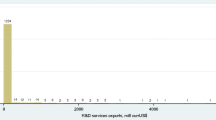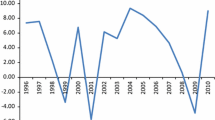Abstract
The paper investigates intersectoral linkages between manufacturing and services under the competent demand pull hypothesis. This hypothesis postulates that the demand pulls the innovative capacities of the suppliers only when and if they are accompanied by qualified knowledge interactions with creative customers. We empirically investigate this hypothesis based on the sector-level data of nineteen (manufacturing and service) sectors in fifteen EU countries over the period 1995–2007. We adopt the input–output framework to assess the strength of the inter-sectoral intermediate goods transactions. Our main findings confirm that demand actually pulls technological change only when it comes from competent customers able to implement effective user-producer knowledge interactions. The results stress the relevance of the transactions-cum-knowledge interactions between the knowledge intensive business service sectors and the manufacturing industries.
Similar content being viewed by others
Notes
See the excellent review paper by Godin and Lane (2013) for a complete discussion on the origins, development and death of demand pull hypothesis within innovation studies. The suggestion to recognize this related strand of the literature is the merit of an anonymous referee to whom we are very grateful.
For a full list of sectors taken under analysis, see “Appendix 1”.
We follow the same method to calculate the supply-side variable described and used in Antonelli and Gehringer (2013a).
We recognize the need to account for the effects of the sector’s internal R&D efforts. In our previous investigations, however, this variable was never significant, Antonelli and Gehringer (2012, 2013a). This was also the case in the present analysis, except for one case, namely for rubber and plastic products. There is another important limitation related to R&D data. Since data on sectoral R&D expenditures covering our sample are very incomplete, we would lose several observations by including it. Thus, in our main estimation procedure, we report the results from specification without R&D variable. Moreover, as explained below, the application of the DOLS procedure makes sure that there is no omitted variables problem.
This effect refers to the supply-push hypothesis between the supplying sector i (on the left-hand side) and the receiving sector j (on the right-hand side). We do not exclude this dynamics from being actually effective, but we concentrate on the demand pulling dynamics and overcome the possible reversal causality by means of an appropriate econometric methodology.
Under cointegration the error term is stationary; it becomes I(0). An I(0) variable which oscillates around a constant mean is statistically not able to systematically influence the non-stationary dependent variable. Consequently, it can be concluded that omitted variables do not affect and bias our results. Omitted variables could refer to different factors, such as institutional variables (for instance, industrial policies applied in certain countries and in certain sectors) but also other variables (e.g. human capital, specific innovation inputs).
Following the seminal contribution by Solow (1957), this alternative indicator has been often referred to in different fields of the applied work to measure innovative outcome.
Detailed information regarding the data source for our investigation is provided in “Appendix 2”. It also contains the correlation matrix and descriptive statistics of the variables.
We are thankful to the anonymous referee for the suggestion to complete the picture with the pooled estimation. It constitutes indeed an important preliminary check before proceeding to a more detailed sector-to-sector analysis. We limit the discussion of these results to a minimum and refer to a more extensive treatment of the issue in Antonelli and Gehringer (2012).
In the last row, we report the standardized coefficients relative to sectoral aggregate demand (AD).
Crucially, however, the results differ in the magnitude. This derives from the fact that in the pooled regressions the estimated coefficients measure a simple averaged impact of each sectors competent demand on the system-level TFP growth, whereas in the sectoral estimations this impact accounts for more precise features of sector-to-sector interactions.
References
Acs, Z. J., Anselin, L., & Varga, A. (2002). Patents and innovation counts as measures of regional production of new knowledge. Research Policy, 31, 1069–1085.
Antonelli, C. (2008). Localized technological change: Towards the economics of complexity. London: Routledge.
Antonelli, C. (Ed.). (2011). Handbook on the economic complexity of technological change. Cheltenham: Edward Elgar.
Antonelli, C. (2013). Knowledge governance: Pecuniary knowledge externalities and total factor productivity growth. Economic Development Quarterly, 27(1), 62–70.
Antonelli, C., & Gehringer, A. (2012). Knowledge externalities and demand pull: The European evidence. LEI & BRICK Working Paper n. 14.
Antonelli, C., & Gehringer, A. (2013a). Demand pull and technological flows within innovation systems: The intra-European evidence. Department of Economics S. Cognetti de Martiis, Working Paper n. 01.
Antonelli, C., & Gehringer, A. (2013b). The cost of knowledge and productivity dynamics: An empirical investigation on a panel of OECD countries. University of Turin and University of Göttingen, Mimeo.
Arthur, W. B. (2007). The structure of invention. Research Policy, 36(2), 274–287.
Boyd, J., & Prescott, E. (1986). Financial intermediary-coalitions. Journal of Economic Theory, 38(2), 211–232.
Crespi, F., & Pianta, M. (2007). Innovation and demand in European industries. Economia Politica Journal of Institutional and Analytical Economics, 24, 79–112.
Davidson, P. (2001). The principle of effective demand: Another view. Journal of Post Keynesian Economics, 23(3), 392–409.
Diamond, D. (1984). Financial intermediation and delegated monitoring. Review of Economic Studies, 51(3), 393–414.
Doloreaux, D., & Shearmur, R. (2012). How much does KIBS contribute to R&D activities of manufacturing firms? Economia Politica Journal of Institutional and Analytical Economics, 3, 319–342.
Edquist, C., & Zabala-Iturriagagoiti, J. N. (2012). Public Procurement for innovation as mission oriented innovation policy. Research Policy, 41(10), 1757–1769.
Gehringer, A. (2011). Pecuniary knowledge externalities across European countries—are there leading sectors? Industry and Innovation, 18(4), 415–436.
Godin, B., & Lane, J. P. (2013). Pushes and pulls: Hi(S)tory of the demand pull model of innovation. Science Technology and Human Values, 38(5), 621–654.
Greenwood, J., & Jovanovic, B. (1990). Financial development, growth, and the distribution of income. Journal of Political Economy, 98(5), 1076–1107.
Griliches, Z. (1979). Issues in assessing the contribution of research and development to productivity growth. Bell Journal of Economics, 10(1), 92–116.
Griliches, Z. (1992). The search for R&D spillovers. Scandinavian Journal of Economics, 94, 29–47.
Jorgenson, D. W., Gollop, F. M., & Fraumeni, B. M. (1987). Productivity and U.S. economic growth. Cambridge, MA: Harvard University Press.
Jorgenson, D. W., & Griliches, Z. (1967). The explanation of productivity change. Review of Economic Studies, 34(3), 249–283.
Kaldor, N. (1966). Causes of the slow rate of growth in the United Kingdom. Cambridge, MA: Cambridge University Press.
King, R. G., & Levine, R. (1993). Finance, entrepreneurship, and growth: Theory and evidence. Journal of Monetary Economics, 32(3), 513–542.
Kline, S. J. (1985). Innovation is not a linear process. Research Management, 28, 36–45.
Mowery, D., & Rosenberg, N. (1979). The influence of market demand upon innovation: A critical review of some recent empirical studies. Research Policy, 8(2), 102–153.
Nelson, R. R. (2013). Demand supply and their interaction on markets as seen from the perspective of evolutionary economic theory. Journal of Evolutionary Economics, 23(1), 17–38.
Nelson, R. R., & Consoli, D. (2010). An evolutionary theory of household consumption behavior. Journal of Evolutionary Economics, 20(5), 665–687.
Pakes, A., & Griliches, Z. (1980). Patents and R&D at the firm level: A first report. Economics Letters, 5, 377–381.
Saviotti, P. P., & Pyka, A. (2013a). From necessities to imaginary world: Structural change, product quality and economic development. Technological Forecasting and Social Change, 80(8), 1499–1512.
Saviotti, P. P., & Pyka, A. (2013b). The co-evolution of innovation demand and growth. Economics of Innovation and New Technology, 22(5), 461–482.
Schmookler, J. (1966). Invention and economic growth. Cambridge, MA: Harvard University Press.
Schumpeter, J. A. (1947). The creative response in economic history. Journal of Economic History, 7(2), 149–159.
Solow, R. M. (1957). Technical change and the aggregate production function. Review of Economics and Statistics, 39, 312–320.
Stock, J. H., & Watson, M. W. (1993). A simple estimator of cointegrating vectors in higher order integrated systems. Econometrica, 61(4), 783–820.
Von Hippel, E. (1993). The sources of innovation. Oxford: Oxford University Press.
Von Hippel, E. (1994). Sticky information and the locus of problem-solving: Implications for innovation. Management Science, 40(4), 429–439.
Von Hippel, E. (1998). Economics of product development by users: The impact of sticky local information. Management Science, 44(5), 629–644.
Weitzman, M. L. (1996). Hybridizing growth theory. American Economic Review, 86(2), 207–212.
Weitzman, M. L. (1998). Recombinant growth. Quarterly Journal of Economics, 113(2), 331–360.
Wooldridge, J. M. (2009). Introductory econometrics: A modern approach. Mason, OH: South-Western Cengage Learning.
Acknowledgments
The authors acknowledge the institutional support of the research project ‘Incentive Policies for European Research’ (IPER) and the funding of the European Union D.G. Research with the Grant number 266959 to the research project ‘Policy Incentives for the Creation of Knowledge: Methods and Evidence’ (PICK-ME), within the context of the Cooperation Program/Theme 8/Socio-economic Sciences and Humanities (SSH), both in progress at the Collegio Carlo Alberto and the University of Torino.
Author information
Authors and Affiliations
Corresponding author
Appendices
Appendix 1
Countries included in the analysis are: Austria, Belgium, Czech Republic, Denmark, Finland, France, Germany, Hungary, Italy, the Netherlands, Portugal, Slovakia, Spain, Sweden and the UK.
See Appendix Table 4.
Appendix 2
Table 5 summarizes information concerning the definition of variables and their statistical sources.
See Appendix (Tables 5, 6, 7).
Appendix 3
Below we show the details of the unit root test, of cointegration test (Table 8) and of the DOLS estimations (Table 9).
Rights and permissions
About this article
Cite this article
Antonelli, C., Gehringer, A. The competent demand pull hypothesis: which sectors do play a role?. Econ Polit 32, 97–134 (2015). https://doi.org/10.1007/s40888-015-0003-1
Received:
Accepted:
Published:
Issue Date:
DOI: https://doi.org/10.1007/s40888-015-0003-1




